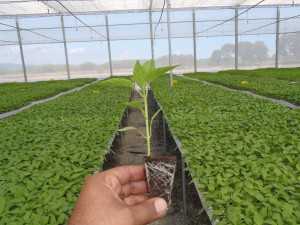8 Tips To Better Manage Vegetable Transplants
Transplant production is a logical, step-by-step process where many factors need to be considered to produce quality plants. Ajay Nair, assistant professor and vegetable Extension specialist at Iowa State University, provides eight tips for you to bear in mind to grow healthy transplants and get the most out of your crop.

- Buy your seed from a trustworthy source. “A lot of diseases can come on the seed,” Nair cautions. “Commercial vendors do a good job of keeping their seed clean and free of disease. If you are saving seed, be sure to disinfect it using a hot water treatment. Ohio State University has a great publication on seed treatment with hot water,” he says. (http://bit.ly/1DC8cuP)
- Timing is everything. Proper starting time for seeding is key to making sure your transplants are ready for transplanting. If you seed too early, transplants may sit in the flats longer and stretch. Delaying seeding will lead to transplants that don’t reach the optimal stage for transplanting.“The most important part is to know how the transplant grows, and how long it takes to grow — cover your bases and do your research. If you don’t know, you’re just experimenting,” Nair says.
- Size is also everything. Before growing your transplants, you need to determine what size you want them to be. Trays come in sizes of 50, 72, 128, 256 cells and upward, and as Nair explains it, the smaller the tray size, the larger your transplants will be.For example, if you’re using a 50-cell tray, it will hold more growing media, and you’ll get a bigger plant, but you are compromising on the space. “There needs to be a harmonious mix between not having too few cells, and not having too many.”
- Tightly control your environment. Make sure your transplant production area has adequate airflow, Nair says. If you skip this step, you can invite disease as a result of high humidity. “Install a small fan that will circulate the air inside. Keep air moving,” he says.Regarding temperatures, Nair suggests the ideal range for summer vegetables to be between 70oF and 72oF. For cool-tolerant crops such as brassica and lettuce, keep the temperatures between 60oF and 65oF, he says.
- Irrigate adequately. Nair suggests that when you put the seed in the cell, apply enough moisture to keep the cell moist, not soaked. As plants emerge, the media will dry quicker, and will need more frequent watering.
- Purchase the correct growing media. The media is responsible for a quality transplant, Nair says. “The best growing media will have good drainage. It should hold onto moisture, but not in excess, and it should provide good aeration.”Many growing media contain peat moss, and may have perlite and vermiculite, which provide aeration, allow better drainage, and modulate media temperature.
- Develop a good nutrition plan. Nair suggests that you start fertilizing transplants once they have emerged — about two to three weeks after seeding. “The growing mix usually has a starting fertilizer, and will provide nutrients for some time,” he says.For tomatoes in particular, the first fertilization is three weeks after seeding, and growers should apply about 150 parts per million (ppm) of nitrogen two to three times during week three. For week four, apply 200 ppm two to three times; and in week five reduce to 150 ppm to start hardening the transplants. By week six, the transplants are getting ready to be moved out of the greenhouse to be hardened off.
- Schedule correctly to avoid transplant shock. “After you grow your transplants, you must move them outside under shade so they can acclimatize to the outside conditions. Otherwise they will experience shock,” Nair says. “They need to get used to the breeze as well as the daytime and nighttime temperatures.”Also, the day before you put your transplants into the ground, Nair suggests applying fertilizer on the flat so the plants have some nutrients, which will help them come out of shock. Add approximately 200-300 ppm of nitrogen, using a 20-20-20 (N-P2O5-K2O) fertilizer solution.
2
2
5
8 Tips To Better Manage Vegetable Transplants




